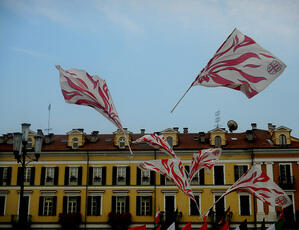The ESPON project TOWN is looking at small and medium sized towns across Europe. The workshop held in Leuven heard about the progress of this study. In particular it heard about some of the examples of how well small towns are performing.
Alba is in the Province of Cuneo, in the south of Piedmont Region in Italy. Traditionally it was very isolated – no roads or railways connected it to anywhere. Until the 1950s it remained a poor agricultural area. Since then the region has achieved significant growth. Its success came through a combination of factors. The local agriculture was the starting point, and high quality food and wine became the area’s trademark. The hazlenuts grown there are the basis for the globally famous Nutella spread. Ferrero Rocher is also produced from here. Last but not least there is the Barolo wine.
So multinational firms are operating here, but there is also a “made in Italy” network of small and medium-sized enterprises that originally served the big firms but now have multi-national presence in their own right. These industries are backed by a high quality landscape and marketing of the food as part of local culture, e.g. through fairs and festivals. Thus a strong network of tourism-focused SMEs has been grown, with smart local entrepreneurs.
So the development model here is to combine local resources with a very strong set of local relations. However, there are still weaknesses. There is still is lack of infrastructure and accessibility, and also low levels of education. With success, the environment is also suffering (e.g. from traffic congestion).
Crucially a sort of tacit agreement has been nurtured between entrepreneurs and workers and the public administrations. However, the big question is will the new managerial class continue to support this territorial development model? While their parents and grandparents were very tied to the place, bright young people now leave home to study abroad and the market for them is global.
Forfar, Scotland’s “Bridietown”?
The night before I flew off to Leuven I was speaking to a meeting of local politicians, council officials, community activists and local traders in the small Scottish town of Forfar, some 20kms north of Dundee. I had been asked to help in a discussion about better promotion of the town. One problem we have in Scotland is that because we do not have the commune / municipality level of government, and a local council area is likely to include within it several small towns, there is no obvious institution to promote the town itself.
I was able to draw on some of the work that we did in the Trans-in-Form project. In particular I pointed to the work that Suwalki had done. I showed them the Suwalki website with its logo of the smiling polar bear, having explained Suwalki’s fame for being the coldest spot in Poland! I also showed them a website from another part of Scotland. I Love Clarkston (www.Iloveclarkston.com) is an initiative of the local Business Improvement District (BID). In a BID businesses agree to pay an additional local tax to generate money that is then invested in projects to boost business in that district (usually a town centre). The website of the Clarkston BID strongly promotes local shopping, e.g. highlighting parking but also a local “loyalty scheme” which rewards local shoppers.
There was a wide ranging discussion about what actions might be taken in Forfar. The town is famous for its “bridies” – a sort of meat pie invented there by a local resident, Mrs Bridie. Maybe this could become the basis for a logo and a promotion of Forfar as a traditional Scottish small town. At least that is the angle that the local newspaper picked up on www.eveningtelegraph.co.uk
Picture: Cuneo, Italy by paolagospo via Flickr

